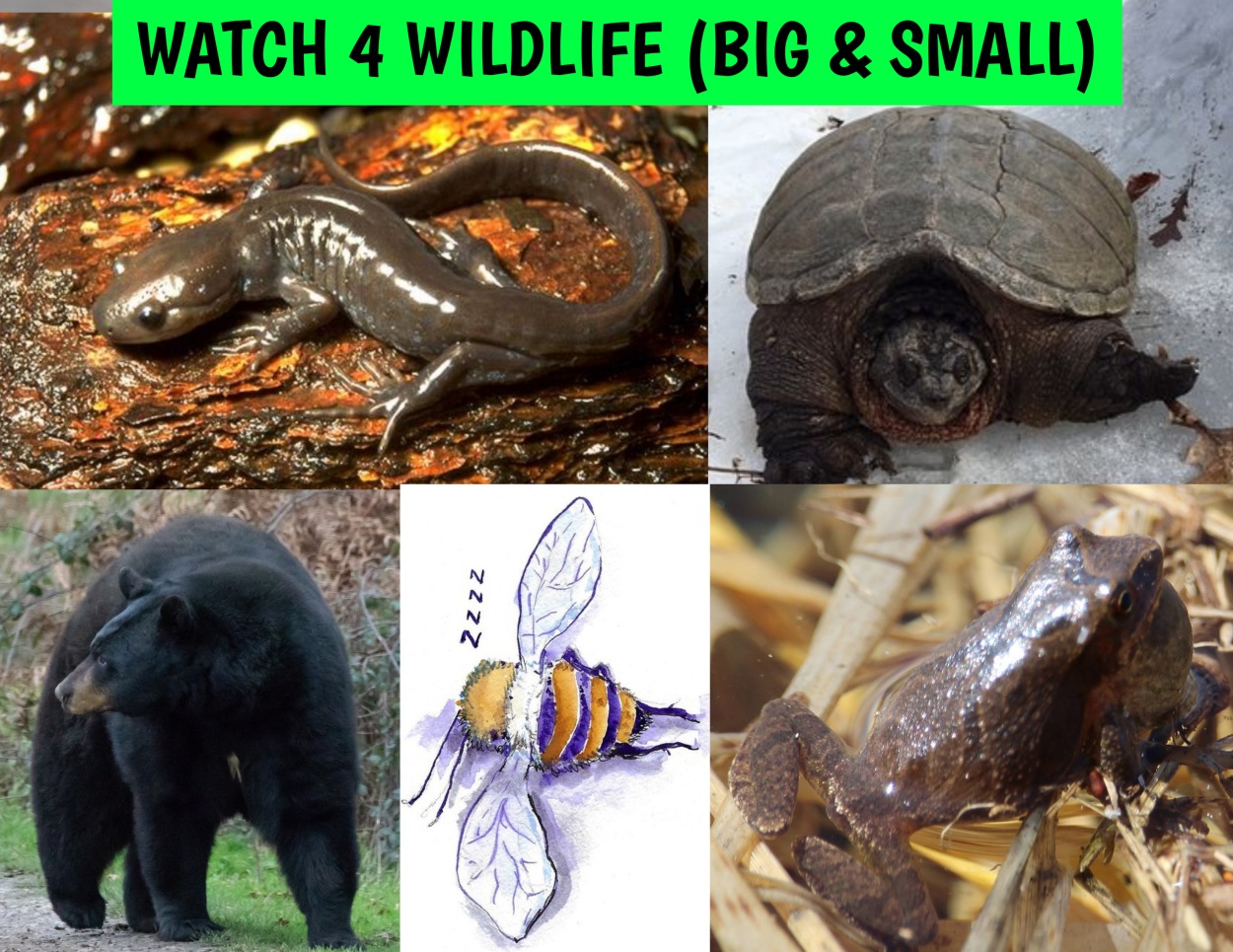WATCH 4 WILDLIFE (Big & Small)
Hello from Kelly at Think Turtle Conservation Initiative
As we head into Easter weekend and April, the forecast in most regions of Ontario includes some double-digit temperatures; however, nighttime temperatures are still cool. Some wildlife (animals and plants) are stirring, but some are not. It is essential to look out for the species that are and not disturb those still waiting to be ready.
The unseasonable winter has set the scene for early emergence from hibernation, such as the endangered Jefferson salamander, as reported in The City of Burlington. This year marks the earliest annual breeding migration in twelve years. As part of a species management plan, the City routinely closes King Road from North Service Road to Mountain Brow Road each year so the salamanders can safely cross to breeding ponds. Rain in the forecast could prompt more salamander activity.
The frogs are out and making no secret of it, and the Ministry of Natural Resources and Forestry reminds us that bears are out ahead of their food source. After the mild winter, we can expect anomalies in wildlife behavior, migration, and reproduction timelines to become evident in the days, weeks, and months ahead.
With the ice breaking up and a stretch of sunny days in the forecast, turtles will soon begin to make a prominent showing. Spotted Turtles are the most cold-tolerant Ontario turtle species and are often the first to emerge from brumation to bask in the spring, sometimes sunning themselves next to mounds of melting snow.
WILDLIFE ALERT
After coming out of hibernation, it takes time for animals to regain their depleted energy stores and get their metabolism back to normal. During the winter to spring transition, fluctuations in temperature and weather patterns are to be expected, and this can be a challenge for all manner of wildlife fresh out of winter dormancy. Please be mindful of wildlife activity on and near roads and trails, as the animals may not be sure-footed and swift enough to get off the roads. Remind other motorists in your household and visitors to the area. For your sake and their sake, please be alert to potential wildlife encounters while driving or doing yard work.
SPRING CLEAN UP
No one can deny the excitement and sense of renewal spring brings. It has become synonymous with spring cleaning, both inside and outside. An important tip from horticultural experts is to resist the urge to start spring cleaning outside too soon.
Most often, landowners bound into spring clean their property and garden more for their sake. It may have to do with being eager to get to new plantings, time constraints, what the neighbors may think of a messy yard, or because it is a way to be outdoors and feel productive. We all experience some or all of this. However, it is essential to remember that the soil, leafy debris, plant stems, dormant grass, hollowed-out logs, etc, are part of a living ecosystem and habitat for insects and pollinators we solely rely on.
Experts differ on the temperature consistency at which to begin the outdoor spring cleanup, but they unanimously agree that waiting until there is no risk of nighttime frost and “how” you proceed with the spring cleanup is crucial to avoid harming butterflies, bees, and other pollinators wintering in last year’s leaf litter and hollowed-out plant branches.
A proper spring cleanup should not be destructive. By taking the time to ensure that overwintering pollinators have enough time to emerge before embarking on the cleanup process, homeowners and gardeners will benefit from the ecological services a healthy population of pest-munching insects and pollinators offers.
The following are some links we sourced on the subject that offer some insight into when and how to do the spring clean-up. We don’t profess to be experts in matters of gardening and encourage readers to consult experts on the subject if they have questions.
When Should You Do Spring Garden Cleanup?
https://www.gardenmyths.com/spring-garden-cleanup/
Spring Cleanup Advice – Do it Right
https://www.gardenmyths.com/spring-cleanup-advice/
Thank you for protecting wildlife and critical habitat and contributing to environmental sustainability.
With Thanks & Appreciation,
Kelly Wallace, Managing Director
Think Turtle Conservation Initiative
Cell/Text: 647-606-9537
E-mail: thinkturtle@yahoo.com
Facebook: thinkturtleci
Username: Wallace Kathleen Kelly
Jefferson Salamander Photo: Wikipedia
Spring Peper Photo: T.A. Mapes
Black Bear Photo: Pixabay
Website: thinkturtle.ca
Facebook Post: #1174

